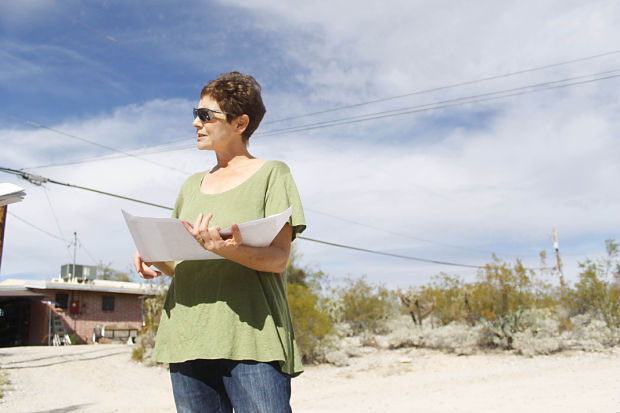The developers of a contentious project near Saguaro National Park have decided to pull back and re-group before pushing forward with their plan to build a bike-themed resort.
Kelley Matthews and Peter Lasher’s application for a conditional use permit was scheduled for a Pima County Board of Supervisor’s vote on Tuesday.
The permit was needed because the area is zoned for a specific type of residential housing and lies in the one-mile buffer zone around Saguaro National Park.
The county staff recommended denial of the permit, partly because of vocal public opposition.
“It just doesn’t make sense to demand a vote on Tuesday,” Matthews said. “I think we need some time to have a better approach.”
If the board were to vote down their permit application, they would have had to wait a year before reapplying, said their attorney, Larry Schubart.
By withdrawing their application, they can choose to restart the permitting process from step one when they are ready.
Preliminary hearings earlier this year drew dozens of opposing residents who said allowing the permit would create a “domino effect” and lead to more commercial development that would endanger the park.
David Hoffman, one of the neighborhood opposition organizers, without official word from the Board of Supervisors the item would be removed from the agenda, they still plan to attend the meeting.
“We are Saguaro National Park’s last line of defense against inappropriate development,” Hoffman said.
Communication issues
Lasher rode his bike past vacant land on Old Spanish Trail for more than two decades, daydreaming about a getaway and training facility for cyclists.
But it was Matthews, a retired designer, who spearheaded the plans for the bike ranch after the couple purchased the 45-acre property for $830,00 last year.
“We thought we had the perfect idea,” Lasher said.
Their preliminary plans included guest casitas, a training facility, bike shop and seven homes.
To make their plan a reality, they needed a conditional use permit for a “minor resort,” which would allow them to have up to 50 units spread over their 45 acres, whereas the typical use with their zoning is one unit per 3.3 acres.
Matthews said they want to build in an environmentally friendly way and designate 83 percent of the property as protected open space.
In the view of internationally recognized cycling events like El Tour de Tucson, Matthews and Lasher believe their project would contribute positively to Tucson’s economy.
“We came out of retirement to do something that we thought would benefit the whole community,” Matthews said.
However, the plan hasn’t always been translated clearly to the public.
Matthews was required to notify residents who live within 1,000 feet of the property of the plans. She said they sent letters to 39 households and heard mixed, but not entirely negative, feedback.
It wasn’t until a May 21 hearing that they realized the breadth of the opposition to the project. More than 120 community members attended and most spoke against their development.
Concerns included increased vehicle and cycling traffic, loss of animal habitat, water use and sewage management.
Robert and Kay Colclazier didn’t attend the meeting but heard about it from their neighbors. They’ve lived near Saguaro National Park for more than 20 years. When asked about the development project, Kay, 82, grimaced and pointed both thumbs down.
“What about the water required to build, let alone what to do when all those sweaty bicyclists come in each afternoon,” she said.
Perhaps the bike ranch’s biggest neighbor is Saguaro National Park, which is ringed by a one-mile buffer zone.
“The real intent is to preserve and protect open space and land near the vicinity of public parks,” said Thomas Drzazgowski, of the county’s Development Services Department.
Matthews and Lasher believe the bike ranch does this because the buildings are consolidated, not spread out like individual homes.
Opponents of the project say they don’t trust the developers’ intentions and worry that if the bike ranch goes bust, a less favorable development could take its place.
“It doesn’t matter if it’s a bike ranch or a yoga ranch or whatever else, we would like to see development done outside the one-mile buffer zone of Saguaro National Park,” said Monica Christensen, who lives about a mile from the property.
None of the cyclists resting under a ramada near the entrance to Saguaro National Park on a recent morning had glaring concerns about the bike ranch, though some knew little about the project.
“It seems like a very reasonable proposal,” said Jan Johnson.
The 65-year-old rides up Old Spanish Trail about once a week and said the more cyclists are on the road, the more visible and safe they are from vehicle traffic.
Matthews and Lasher hope to assuage the concerns of residents before reapplying for a conditional use permit from the county.
Darla Sidles, superintendent of Saguaro National Park, said she opposed the bike-ranch plan in its current iteration but would be willing to work with the developers to create a more agreeable plan.
“A mine or power plant would be incompatible with park values,” Sidles said. “Bicycle use and that sort of thing is not incompatible.”
Drzazgowski said it’s not impossible for a commercial project to succeed in the buffer zone.
“Working with neighbors and coming back with solutions, with collaborations with all property owners and affected neighbors, can be a positive,” Drzazgowski said.





